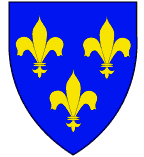Blue Flag Iris - Spring flowers with a history
 The Blue Flag Iris (Iris virginica, L. ssp shrevei) is a common plant in the Eastern US States, found in marshy soils stream margins and lake shores. (Botanist Ralph Shreve 1927 identified the ssp. with smaller flowers and lighter colloured seeds than ssp.virginica) Iris is the name of the Rainbow Goddess of Greek Mythology.(Pic (c) Lord Patel)
The Blue Flag Iris (Iris virginica, L. ssp shrevei) is a common plant in the Eastern US States, found in marshy soils stream margins and lake shores. (Botanist Ralph Shreve 1927 identified the ssp. with smaller flowers and lighter colloured seeds than ssp.virginica) Iris is the name of the Rainbow Goddess of Greek Mythology.(Pic (c) Lord Patel)
There may be up to 6 blue-violet flowers per 20"-40" round stem, which is clasped by shorter spear like green leaves, side branches will flower at the same height as the main stem. The flowers appear to have 9 petals but in reality has 3 sepals, 3 petals and 3 petal like stems to the pollen bearing styles.3/4" across the flowers are smaller than ssp. virginica.
The broad sepals have a yellow mid rib with a distincly hairy yellow spot at the base.The narrower petals are smaller than the petals.2 papery bracts cover the flower base.
The three lobed fruit has single seed rows per lobe (see pic) and the whole is about 2 cms.  (3/4") long. The dark brown Seeds (virginica = lighter brown) germinate easily after 3 to 4 weeks of cold treatment at 32-38 deg F. Seedlings bloom the second year. Best germination occurs at 80 deg F or over.Seeds available here.
(3/4") long. The dark brown Seeds (virginica = lighter brown) germinate easily after 3 to 4 weeks of cold treatment at 32-38 deg F. Seedlings bloom the second year. Best germination occurs at 80 deg F or over.Seeds available here.
The rhizomatous root is perennial with fibrous roots. It contains a glucoside Iridin which is essentiually toxix but is used in hebal medicine as a purgative and is said to clear the liver. Indians and pioneers are said to have used the leaves pounded and boiled as a dresing for wounds and bruises.
The related Italian species Iris pallida and Iris florentina is called orris and are harvested near Florence, Italy. The roots are sold as " ghiaggiuolo." Sometimed the darker Iris germanica is also used.Three year old rhizomes, resembling ginger, are dug up in August, stripped of their rootlets and bark, and then dried until they have a chalky appearance. The dried orris root smells of violets. It is used primarily as a base for natural toothpastes, and has been used as a fixative in perfumes to enhance other aromas since the Ancient Greeks used it.
Powdered orris root lends a pleasant scent to freshly laundered linens and to potpourri. It also can be used as a snuff to relieve sinus headache and as a stabilizer in cosmetics. It is also used in Bombay Sapphire Gin an ersatz brand launched by the privately owned Bacardi which attempts to persuade the user that it's origins lie in the Indian Raj who mixed gin with their anti-malarial quinine to make their medicine more sociable and enjoyable - and often dug their grave with it.
In Voodoo, orris is known as Love Drawing Herb (and Queen Elizabeth root). The powder form is blown onto clothes, sheets, and so forth to make sure that the owner returns one's love.
Orris root contains Starch, myristic acid, iridin, nine recently identified anti-inflammatory flavonoids and four isoflavone glycosides: iriskashmirianin 4'-O-beta-D-glucoside (1), nigricin 4'-O-beta-D-glucoside (2), irilone 4'-O-beta-D-glucoside (3) and iridin (4). The French Fleur de lys has had many claimed origins it may however lie in the related Yellow Flag in Europe. Thed famous Scottish heraldic scholar Alexander Nisbet suggested in 1722, after distinguishing between the natural lily, "the lily of the garden", and the stylised lily, "the lily of the flag", observed of the oriflamme ~
The French Fleur de lys has had many claimed origins it may however lie in the related Yellow Flag in Europe. Thed famous Scottish heraldic scholar Alexander Nisbet suggested in 1722, after distinguishing between the natural lily, "the lily of the garden", and the stylised lily, "the lily of the flag", observed of the oriflamme ~
The other lilies, as those of France, so well known ....... having only but three leaves, is by the Latins called flos iridis, and by the French fleur de l'iris; being always called the flower of the rainbow or iridis, which the French call fleur-de-lis, from the river Lis, as some will; and anciently flams or flambs, which signifies the same: Whence the Royal Standard of France was called the oriflam or oriflambe, being a blue banner, charged with golden flower-de-luces, a suitable figure, say some, for the Franks, who come from the marshes of Friezland.
The European Yellow Flag Iris pseudacorus to which Nisbet refers, has been imported as a garden plant into the US probably from Canada in about 1900 and is the only yellow iris seen in the US. Of course the Yellow Flag will appear a few times this weekend at the Indy 500 to slow everybody down aftyer the apparently inevitable accidents. 

2 comments:
We've always called them swamp iris here in upstate NY. I went to post a pic here (from last year) and couldn't figure out how to do it. They are lovely!
aj
Great photos, and thanks for the information.
The National Aquarium recently launched a blog (http://nationalaquarium.wordpress.com/) and we've been posting visitors' photos from Flickr. If you'd like us to possibly include your photos, you can add them to our Flickr group (http://www.flickr.com/groups/aqua/pool/).
Also, you can check out our latest entry about the Blue Flags here: http://nationalaquarium.wordpress.com/2008/05/23/blue-flags-wave-in-waterfront-park
Post a Comment